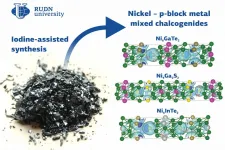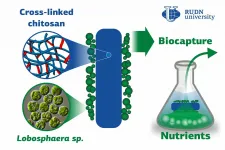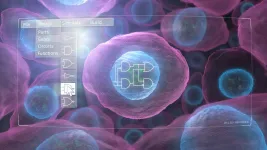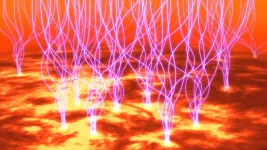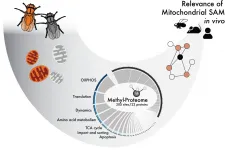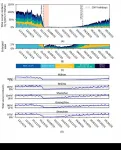(Press-News.org) DURHAM, N.C. -- Duke researchers have been studying something that happens too slowly for our eyes to see. A team in biologist Philip Benfey's lab wanted to see how plant roots burrow into the soil. So they set up a camera on rice seeds sprouting in clear gel, taking a new picture every 15 minutes for several days after germination.
When they played their footage back at 15 frames per second, compressing 100 hours of growth into less than a minute, they saw that rice roots use a trick to gain their first foothold in the soil: their growing tips make corkscrew-like motions, waggling and winding in a helical path.
By using their time-lapse footage, along with a root-like robot to test ideas, the researchers gained new insights into how and why plant root tips twirl as they grow.
The first clue came from something else the team noticed: some roots can't do the corkscrew dance. The culprit, they found, is a mutation in a gene called HK1 that makes them grow straight down, instead of circling and meandering like other roots do.
The team also noted that the mutant roots grew twice as deep as normal ones. Which raised a question: "What does the more typical spiraling tip growth do for the plant?" said Isaiah Taylor, a postdoctoral associate in Benfey's lab at Duke.
Winding movements in plants were "a phenomenon that fascinated Charles Darwin," even 150 years ago, Benfey said. In the case of shoots, there's an obvious utility: twining and circling makes it easier to get a grip as they climb towards the sunlight. But how and why it happens in roots was more of a mystery.
Sprouting seeds have a challenge, the researchers say. If they're to survive, the first tiny root that emerges has to anchor the plant and probe downwards to suck up the water and nutrients the plant needs to grow.
Which got them thinking: perhaps in root tips this spiral growth is a search strategy -- a way to find the best path forward, Taylor said.
In experiments performed in physics professor Daniel Goldman's lab at Georgia Tech, observations of normal and mutant rice roots growing over a perforated plastic plate revealed that normal spiraling roots were three times more likely to find a hole and grow through to the other side.
Collaborators at Georgia Tech and the University of California, Santa Barbara built a soft pliable robot that unfurls from its tip like a root and set it loose in an obstacle course consisting of unevenly spaced pegs.
To create the robot, the team took two inflatable plastic tubes and nested them inside each other. Changing the air pressure pushed the soft inner tube from the inside out, making the robot elongate from the tip. Contracting opposing pairs of artificial "muscles" made the robot's tip bend side to side as it grew.
Even without sophisticated sensors or controls, the robotic root was still able to make its way past obstacles and find a path through the pegs. But when the side-to-side bending stopped, the robot quickly got stuck against a peg.
Finally, the team grew normal and mutant rice seeds in a dirt mix used for baseball fields, to test them out on obstacles a root would actually encounter in soil. Sure enough, while the mutants had trouble getting a toehold, the normal roots with spiral-growing tips were able to bore through.
A root tip's corkscrew growth is coordinated by the plant hormone auxin, a growth substance the researchers think may move around the tip of a growing root in a wave-like pattern. Auxin buildup on one side of the root causes those cells to elongate less than those on the other side, and the root tip bends in that direction.
Plants that carry the HK1 mutation can't dance because of a defect in how auxin is carried from cell to cell, the researchers found. Block this hormone and roots lose their ability to twirl.
The work helps scientists understand how roots grow in hard, compacted soil.
INFORMATION:
This work was supported by a grant from the National Science Foundation (PHY-1915445, 1237975, GRFP-2015184268), the Howard Hughes Medical Institute, the Gordon and Betty Moore Foundation (GBMF3405), the Foundation for Food and Agricultural Research (534683), the National Institutes of Health (GM122968) and the Dunn Family Professorship.
CITATION: "Mechanism and Function of Root Circumnutation," Isaiah Taylor, Kevin Lehner, Erin McCaskey, Niba Nirmal, Yasemin Ozkan-Aydin, Mason Murray-Cooper, Rashmi Jain, Elliot W. Hawkes, Pamela C. Ronald, Daniel I. Goldman, Philip N. Benfey. Proceedings of the National Academy of Sciences, Feb. 19, 2021. DOI: 10.1073/pnas.2018940118.
A chemist from RUDN University, working with a group of colleagues, synthesized three new chalcogenides (compounds that contain metals and elements from group 16 of the periodic table). The team suggested an unusual approach to synthesis that was based on iodine. An article about the work was published in the Dalton Transactions journal.
Chalcogens are elements of group 16 of the periodic table that include oxygen, sulfur, selenium, tellurium, polonium, and livermorium--an artificial radioactive element. Chalcogenides are compounds of chalcogens with metals that are used as photosensitive ...
Several University of Illinois Chicago faculty members have addressed the issue of how to ethically conduct research with Black populations.
In their paper "Ethics of Research at the Intersection of COVID-19 and Black Lives Matter: A Call to Action," authors Natasha Crooks, an assistant professor, Phoenix Matthews, a professor, both of the UIC College of Nursing, and Geri Donenberg, director of the Center for Dissemination and Implementation Science at the UIC College of Medicine, highlight the historical issues that impact research involving Black populations. They also provide recommendations for researchers to ethically engage Black populations in research. ...
Biotechnologists from RUDN University in collaboration with Lomonosov MSU and Kurchatov institute made an important contribution to the technology of phosphate and nitrate biocapture from wastewater using Lobosphaera algae fixed on the filters.The biomass obtained in the course of this process can be used as a fertilizer. The results of the study were published in the Journal of Water Process Engineering.
Phosphates and nitrates get to the wastewater together with industrial and household waste, especially detergents. Both substances are parts of phosphorus and nitrogen chemical cycles. However, these cycles are disturbed by human activity, as the growing amounts of phosphates and nitrates cannot be processed by water ecosystems. As a result, these substances turn from useful nutrients ...
New Orleans, LA - A retrospective study conducted by LSU Health New Orleans reports that contrary to previous research, most patients who drop out of peritoneal dialysis may do so for psychosocial reasons. The findings are published in The American Journal of the Medical Sciences, available here. The paper inspired a companion editorial, available here.
The research team evaluated the reasons that 27 of the 83 patients enrolled in the peritoneal dialysis program withdrew between 2016 and 2018. Twenty-four or 86% were African American. They found that psychosocial factors, including mental health illness such as anxiety and depression, loss of support networks, or inability to tolerate ...
Since Charles Darwin's day, the abundance of life on coral reefs has been puzzling, given that most oceanic surface waters in the tropics are low in nutrients and unproductive.
But now research, led by Newcastle University and published in in the journal Science Advances, has confirmed that the food web of a coral reef in the Maldives relies heavily on what comes in from the open ocean.
The team found that these offshore resources contribute to more than 70% of reef predator diets, the rest being derived from reef associated sources.
Led by Dr Christina Skinner, now based at the Hong Kong University of Science and Technology, the researchers included collaborators from Woods Hole Oceanographic Institution (USA), Banyan Tree Marine ...
Cooperative operations between a solar observation satellite and a sounding-rocket telescope have measured the magnetic field strength in the photosphere and chromosphere above an active solar plage region. This is the first time that the magnetic field in the chromosphere has been charted all the way up to its top. This finding brings us closer to understanding how energy is transferred between layers of the Sun.
Despite being the brightest object in the sky, the Sun still holds many mysteries for astronomers. It is generally believed that magnetic fields play an important role in heating the solar corona, but the details of the process are still unclear. To solve this mystery it is important to understand the magnetic field in the chromosphere, which is sandwiched ...
Northwestern University synthetic biologist Joshua Leonard used to build devices when he was a child using electronic kits. Now he and his team have developed a design-driven process that uses parts from a very different kind of toolkit to build complex genetic circuits for cellular engineering.
One of the most exciting frontiers in medicine is the use of living cells as therapies. Using this approach to treat cancer, for example, many patients have been cured of previously untreatable disease. These advances employ the approaches of synthetic biology, a growing ...
Every day space telescopes provide spectacular images of the solar activity. However, their instruments are blind to its main driver: the magnetic field in the outer layers of the solar atmosphere, where the explosive events that occasionally affect the Earth occur. The extraordinary observations of the polarization of the Sun's ultraviolet light achieved by the CLASP2 mission have made it possible to map the magnetic field throughout the entire solar atmosphere, from the photosphere until the base of the extremely hot corona. This investigation, published today in the journal Science Advances, has been carried out by the international team responsible for this suborbital experiment, which includes several scientists of the POLMAG group of the Instituto de Astrofísica de Canarias ...
Disorders of the cells' energy supply can cause a number of serious diseases, but also seem to be connected to ageing. More research is needed on mitochondrial function to find future treatments. A new study involving researchers at Karolinska Institutet shows how an important molecule inside the mitochondria affects their function in mice and fruit flies. The study, which is published in Science Advances, adds valuable knowledge on formerly relatively unexplored protein modifications.
In each cell of the body is an organ called the mitochondrion, which converts nutrients in our food to energy. Mitochondria are an essential part of the ...
A combination of robust vaccination programmes and strict physical distancing rules could avoid recurring peaks of COVID-19 without the need to rely on stay-at-home restrictions, according to a new study by epidemiologists and demographers from WorldPop at the University of Southampton, in collaboration with The Chinese University of Hong Kong.
This research used anonymised mobile phone geolocation data with epidemiological and coronavirus case data from China to model the potential impact of vaccination and physical distancing on virus transmission. They predicted the effect of different combinations of interventions on low, medium and high density cities in the country.
The ...
